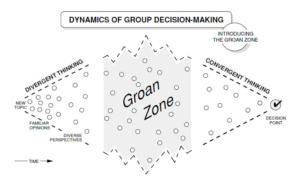#1 Reason Why Design Thinking Will Fail In Your Organisation: People Issues. Fix Them First.

Mohamed Fakihi is a serial entrepreneur, business angel and social activist. Founder and CEO at Kratos Technology. He was also one of the speakers at this year’s Design Thinking Camp Sofia and held a keynote on why design thinking could fail in organizations.
I have always been a supporter of the design thinking methodology: I have been heavily using it with my teams for many years, I held talks and workshops about Design Thinking and Lean, and the benefits it can bring to organizations. However, in the past years, often enough, I also witnessed situations in which Design thinking does not exactly help the organization. Sometimes, the attempts even end up with what some would describe as an epic fail.
Design thinking is a very hyped innovation process that is praised in the press and conferences, but the truth is that design thinking and all co-creation initiatives fail far more often than they do succeed. And this is what this article is about.
Design Thinking: the basics
“Design thinking is a human-centered approach to innovation that draws from the designer’s toolkit to integrate the needs of people, the possibilities of technology, and the requirements for business success, ” explains it clearly Tim Brown from IDEO.
In other words, Design thinking is a methodology to efficiently create innovation. It allows us to design products that people desire, while making sure that those products are not only technically feasible but that they are economically viable as well. So, as you can see now, innovation sits at the intersection of Design, Technology and Business.
The key word about Design thinking is methodology. Hence, it is a process that can be learned. The Design Thinking typical process consists of 5 steps – Empathise, Define, Ideate, Prototype and Test. This process is the methodology’s biggest assets. Thanks to its 5-step process, Design Thinking actually demystifies design for the business.
Design is not the fluffy and almost esoteric thing practiced by capricious geniuses who smoke weed. Thanks to Design Thinking, it is a methodology that can be learned and applied by anyone. This is what actually makes it so attractive for business decision makers and why we are seeing more and more companies adopting it.
The Honeymoоn of Design Thinking Implementation
After seeing Design Thinking applied in many organisations, I have started noticing that they all have the same thing in common. Whomever you’d ask in such organisation who have seen Design Thinking in action will tell you the same thing: “Since we started using Design Thinking, everything is getting better”. It was almost an automatic answer, and it was quite fascinating to see this repeated every time.
Later on, I decided to call this phenomenon the Design Thinking Honeymoon. Why is that?
Because in almost all the aforementioned cases, after a certain period of time, when I asked the same people about Design Thinking I would get a completely different feedback such as:
“We tried it but it doesn’t work for us.”, “We did Design Thinking and it didn’t change anything”,“We didn’t see much value out of it”, “Our teams did not like it.”
In short, what they were all saying was that Design Thinking not only does not work but that Everything Gets Worse Fast because of it.
The practice: Why and when does Design Thinking Fail
We can indeed identify two categories of reasons why Design Thinking fails: it’s either because of the process, or because of the people, in most of the cases. And there are also ways to avoid and fix these two.
Failing and fixing the process
As we’ve seen above, Design Thinking is a process broken down into 5 main steps. Each of these steps has a sub process and a set of methods and tools to transform intputs into outputs that can be used in the next step or to draw the final conclusions. It is important to master the Design Thinking process and apply it properly, especially in the early phase of the methodology adoption, since making mistakes in any of these steps might lead to the complete failure of your Design Thinking initiative.
Empathize: Invest time in personas
The first step is commonly known as the empathise phase. Empathy is the most important tool of the designer when working with clients, users, and customers. To generate innovative design, we must understand the wants and needs of the potential product or service users. Empathic design or user-centered design is all about understanding the psychological and emotional needs of people. This changes the business paradigm where we would build a product and then look for a market segment to sell it to. Instead, we first choose the market segment we want to sell to and we go from there to design a product or service they want and need.
The empathise step usually starts with building your user or customer persona. Most of the teams working with product and service design are familiar with personas and today it is usually something very common in marketing. Personas, unlike customer segments, are easier to empathise with. They are based on the analysis and research of real users and customers, which helps having a much more detailed picture of the ideal user or customer.
What I have often observed is that most teams don’t spend enough time on personas, and they rush into the next phases with half-baked personas. Working with personas can indeed be daunting, especially when we “Know the customers”. A lot of teams can find this work tedious and it might feel like a waste of effort. If you already have a product on the market and some market segmentation, your teams might see this as redundant work where you just put existing information in boxes. Whilst, if you are targeting a new market or looking for product-market fit, the teams can find it hard to collect the right information needed to build the persona and properly split the potential users into homogeneous groups. In all cases, one thing is true — you can never ask too many times the WH-questions: Who, what, why and how.
Keep in mind that if your personas are not right, anything you do afterwards will be going in the wrong direction. So why risk it and not just spend enough time on your personas until you are confident whose problem you’re solving?
Define: First the problem, then the solution
“If I had an hour to solve a problem, I’d spend 55 minutes thinking about the problem and 5 minutes thinking about solutions,” says Albert Einstein. Many have probably come across this quote, as it is often used to illustrate the importance of first understanding the problem before looking for a solution. So, you can guess it, another common mistake that can lead to the Design Thinking initiative’s failure is a bad problem statement during the Define step of the process.
It is of the utmost importance not to start the ideation step before you have properly defined your problem statement. Quite often, organisations are struggling with defining problem statements. The teams are so caught in fire-fighting that they often forget their cadence and that they have to regularly stop and reflect on their actions and priorities. You know your organisation has issues in the define step when you start witnessing a lot of friction between the client-facing teams such as sales, support and the design teams. This can happen because they both perceive different things as reality and do not have a common understanding of what is the customer or user problem.
Ideate: Find the groan zone
Once you have clearly identified a specific problem for one of your personas and that you have properly defined a clear problem statement, comes the ideation step. This is my favourite phase in the design thinking process. It is full of interactive and energetic sessions where you get to think outside the box, throw crazy ideas and use both the first and second system of thinking. Out of the whole process, it is the one with the most fun. However, like all the other process phases, it also comes with a lot of pitfalls to avoid.
As I mentioned above, in the ideation phase we get to use the first and second system of thinking. Which means that we have to use our fast thinking in a divergent phase to generate as many ideas as possible, and then we have to use our slow thinking to analyse and curate the ideas. The graphic depicts how you transit from a divergent to a convergent phase when working in the problem or the solution space.
The divergent part is where you are actually brainstorming and shooting as many ideas as possible, while the convergent part is where you structure all these ideas and select the ones you are going to test out. The transition between these two parts is called the groan zone and one of the trickiest parts is to wrap up the divergent part and to move on to the convergent one.
In many cases, I have seen facilitators miss the groan zone or have issues managing it. Which often leads to endless brainstorming sessions where we don’t get to closure. On the other hand, some teams tend to fall in the other extreme and tame the divergent zone, which can lead to missed ideas and team members losing faith in the brainstorming process.
In addition, mastering the divergent and groan zone is not enough, it is also key to be aware of the convergent zone because this is what you are going to prototype and test. On average, only 1 out of 3000 ideas. So it is very important to have a common understanding of what is a good idea and put in place the tools to scientifically select ideas, so that you don’t fall in the trap of “it’s my ideas against your ideas” but instead “Let’s look at all these good ideas and find the optimal one”.

Most importantly, wherever the discussions might lead, keep in mind:
Prototype: Don’t fall in love with your prototype
With the right idea in hand, comes the time to prototype. The most crucial thing here is DON’T FALL IN LOVE WITH YOUR PROTOTYPE. Far too many people develop emotional ties to their ideas and prototypes. This leads us to be biased and it stops us from being sober in our judgments. You can save months of wasted time if you follow this simple rule: If you don’t love your prototype, just change it or kill it.
Test: Prepare carefully
The last step, the test phase is where you actually make sure that your assumptions are right. When this step is not properly done, the consequences can be catastrophic. Not only you wasted time on the previous steps for nothing, but you might get false results and mislead your team and organisation’s decisions. Teams that fail due to this step do so because they do not prepare their tests properly. Testing a prototype without proper preparation is like going in the ring with a heavyweight boxer with no training. It is pure suicide.
So to avoid getting knocked out, carefully prepare and document your tests. Make sure you know what is the exact assumption or hypothesis we are testing, what are the expected results, what are the actual results, and that all your test data are properly stored and manageable.
Fixing the people issues
I believe that these pitfalls are the ones we should focus on first because not only fixing people issues is way harder than fixing process issues but even if you fix your process without fixing your people issues just won’t work.
Validate your organisation readiness
Before talking about people-specific issues, one of the first challenges that you might come across and that you have to pay special attention to for Design Thinking , is the organisation’s readiness, or lack of such. Trying to implement Design Thinking in an organisation that is not ready for it would be like driving a Lamborghini in a traffic jam. You would be just crawling with an over-performing, over-expensive, uncomfortable and loud car, while people on foot are passing you by. It is completely pointless and, frankly, just a pain.
Creative atmosphere vs creative environment
In one of my previous companies, we decided to adopt a more user-centric strategy and implement design thinking and a lean approach to product development. We invested heavily in reshaping the workspace to facilitate intra-team and inter-team communication, collaboration and co-creation. We built a dedicated design space and a dedicated creativity room with all the bells and whistles à la Google. So, we had a creative environment and it worked pretty well in the beginning, but I missed the fact that although we had a creative environment, we didn’t have a creative atmosphere.
See, a critical thing that might derail your design thinking adoption is missing the right creative atmosphere. You have to make a distinction between a creative environment and a creative atmosphere. A lot of companies invest heavily into creative environments and turn their office into a ridiculous amusement park without any improvement to their teams’ creativity or any innovative output. This is usually because they lack a creative atmosphere.
What I should have paid attention to were symptoms of the lack of a creative atmosphere. One of these symptoms came from my two partners at the time. They were very old-school business people who, at that time, had only experienced classic brick-and-mortar businesses and that was their first tech startup venture. First, they were very resistant to the idea of “wasting” resources and space, which is a clear symptom of organisational unreadiness for co-creation and lack of buy-in. In addition, after we created the creative spaces, they were constantly complaining that the employees were always in those meetings. I everyday get feedback that would sound like: Why are they in meeting all the time? Why are they just having fun there? When are they going to work? What are we paying them for?
Guess what happened? People stopped doing meetings. Which of course meant they stopped being creative and collaborate. As a result, we not only lost all the progress we had made so far, but things got worse, faster.
With that experience, I learned the lesson that you can invest crazy amounts of money in a creative environment. But If you don’t trust your team, you can’t build a creative atmosphere and without a creative atmosphere you cannot succeed at Design Thinking and innovation.
Avoid empty empowerment
The last thing that I want to talk about is the importance of coaching for the success of a Design Thinking initiative. The right coaching is primordial to the success of any change process and not having proper coaching when you implement Design thinking is just a recipe for disaster.
Very often, especially in smaller companies, you can see management doing what is called empty empowerment. They would give very challenging goals to their teams without any support or training, sometimes without the basic resources required to achieve those goals. Therefore, setting them for an inevitable failure.
Real empowerment means that you can only establish challenging goals for an organisation if its people have practiced and learned an effective way of meeting them. This means literally that coaching is a prerequisite to empowerment. If you try to implement Design Thinking in an organisation where the teams did not have the time and resources to practice and learn Design Thinking methodologies and tools in a safe environment, it will only lead to failure and frustration.
In addition to the above, coaching by its nature of an ongoing activity requires constant observation and correction. So, for coaching to be effective it has to be performed by people who are constantly with the coached teams. This is why it is usually not very effective to hire external coaches or have some kind of “Design Thinking committee” for several teams. The people who best fit to coach their teams are either line managers or team leads because they are constantly in touch with the team members and have already setup a rapport with them.
How to make Design Thinking really work
Design Thinking is an amazing methodology to have in every innovative team’s tool belt. However, more often than not, it fails to be adopted in organisations. To maximise the chances of success for your Design Thinking initiative validate your organisation readiness before doing anything, create a creative practice and master the process, understand and implement creative atmosphere, and most importantly, make sure your teams’ leads and managers are properly trained and prepared to coach the rest of your organisation.





























